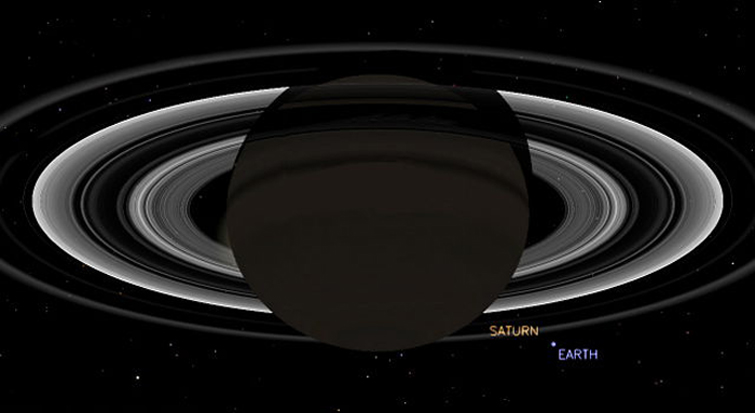Two Distant Spacecraft Set to Take Photos of Earth Friday

In a cosmic coincidence, two NASA spacecraft in orbit around distant planets in the solar system are expected to take photos of Earth tomorrow (July 19).
On Friday, the Cassini spacecraft orbiting Saturn and the Messenger probe orbiting Mercury will train their cameras on Earth, capturing their unique perspectives on humanity's home in the universe.
Messenger's photos will be taken over the course of two days (July 19 to 20), while Cassini will capture its images during a 15-minute window from 5:27 p.m. to 5:42 p.m. EDT (2127 to 2142 GMT) tomorrow. Cassini mission planners are encouraging Earthlings to "wave at Saturn" during the photo window to take part in the project, even though individual people on Earth will be invisible to the probe's cameras. [See amazing photos taken by Cassini]
"What's important about this particular image is that it's the first time that we've known ahead of time that this picture was going to be taken," Mike Simmons, the founder and president of Astronomers Without Borders said of the Cassini photo. "It's an opportunity to bring awareness of our position in space to everyone, not just show a picture after the fact, but make people aware that there's a spacecraft out there that's doing it, and create an event that people will then want to look up, look at Saturn, learn more about it, and maybe even more importantly be involved in it, be a part of it."
Scientists working with Messenger were inspired by the Cassini team's idea to take a photo of Earth. Coincidentally, they saw that Messenger would have a good view of Earth during planned observations aimed at finding natural satellites around Mercury, NASA officials said.
The Messenger team will take its photos at 7:49 a.m., 8:38 a.m. and 9:41 a.m. EDT (1149, 1238 and 1341 GMT) on both July 19 and July 20.
Cassini and Messenger will each capture different parts of the planet Earth in their images. Messenger will see the Middle East, Central Asia and Europe, while North America and part of the Atlantic Ocean will be in sunlight for Cassini's photo, NASA officials said.
Breaking space news, the latest updates on rocket launches, skywatching events and more!
Astronomers Without Borders is calling on photographers of all kinds to send in their photos of Saturn in honor of the Cassini portrait session. Officials with the organization plan on crafting a "zoomable" mosaic image that uses photos of Saturn from Earth to craft a large duplicate of the Cassini picture.
Both photos will take some time to process, but some of the raw images that will be arranged into a cohesive picture from Cassini's photo-snapping session with Earth should be available online as early as July 20.
Editor's note: If you have an amazing night sky photo of Saturn or any other celestial sight that you'd like to share for a possible story or image gallery, please contact SPACE.com Managing Editor Tariq Malik at spacephotos@space.com.
Follow Miriam Kramer @mirikramer and Google+. Follow us @Spacedotcom, Facebook and Google+. Original article on SPACE.com.

Miriam Kramer joined Space.com as a Staff Writer in December 2012. Since then, she has floated in weightlessness on a zero-gravity flight, felt the pull of 4-Gs in a trainer aircraft and watched rockets soar into space from Florida and Virginia. She also served as Space.com's lead space entertainment reporter, and enjoys all aspects of space news, astronomy and commercial spaceflight. Miriam has also presented space stories during live interviews with Fox News and other TV and radio outlets. She originally hails from Knoxville, Tennessee where she and her family would take trips to dark spots on the outskirts of town to watch meteor showers every year. She loves to travel and one day hopes to see the northern lights in person. Miriam is currently a space reporter with Axios, writing the Axios Space newsletter. You can follow Miriam on Twitter.
